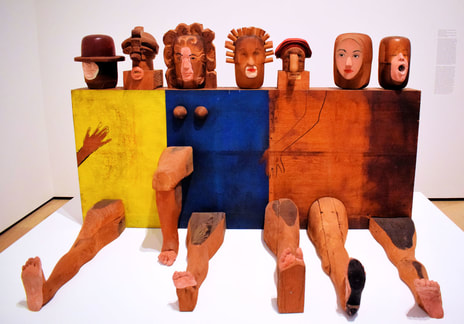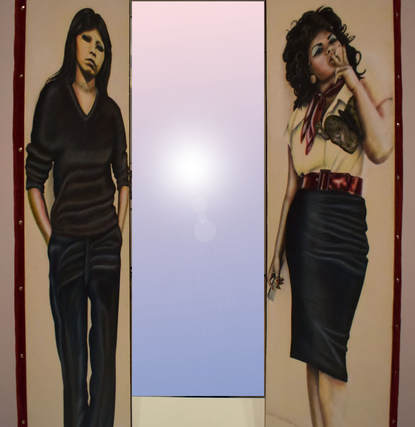- Folio No. 9
- About
- Feral Parrot : The Blog
- INTERVIEWS
- SUBMISSIONS
-
ISSUE ARCHIVE
- PRINT Chapbook No.6 Healing Arts
- Online Issue No.9
- Online Issue No.1 Fall 2016
- Online Issue No.2 Spring 2017
- ONLINE Issue No.3 Fall 2017
- PRINT Vol 72 No 2 Fall 2017
- PRINT Vol 73 No.1 Fall 2018
- ONLINE Issue No. 4 Fall 2018
- Online Issue No.5 Summer 2018
- FOLIO No.1 Fall 2018 VOTE
- ONLINE Issue No.6 Fall 2018 Fall Spirituality
- FOLIO 2 Fall 2019 Celebrating Dia De Los Muertos
- FOLIO No.3 -- Moon Moon Spring 2019
- FOLIO No.4 Celebrating New PCC Writers
- FOLIO No.5 City of Redemption
- FOLIO No.6 Spring 2020
- FOLIO No. 7 - Winter 2021 Into the Forest
- 2022 Handley Awards
- Inscape Alumni Board
- PRINT Chapbook No. 7 Healing Arts
- Blog
- Untitled
 Marisol, Self Portrait, 2017 Image: Veronica Rodriguez Marisol, Self Portrait, 2017 Image: Veronica Rodriguez by Daniela Flores-Rodriguez The Hammer Museum is currently hosting Radical Women: Latin American Art, 1960- 1985, until December 31st, 2017. The exhibit brings a spotlight over artistic practices of Latin American women, and US-born Latina and Chicana artists working during a crucial period in the history of Latin American feminism. One-hundred twenty artists from fifteen countries are represented in the exhibition, spanning the mediums of photography, video, and other experimental hybrid forms. Radical Women reveals the political and sociocultural views of Latin American women that were overlooked during this key time period. The exhibit inspires many new perspectives, using approaches from the whimsical to heart-wrenching to affect its audience. Due to controversial views pertaining to gender in their time, many of these artists were limited in their ability to exhibit their work in their own countries, and consequently by a perceived lack of popular audience in countries abroad. As such, this presentation of the work gives a collectively stronger voice to the artists and the issues Latin American women have struggled past and continue to fight through today. The series explores several themes of the oppression of women and their desperation to gain both political and social rights. It features artists such as Lygia Clark, Ana Mendieta, Marta Minujín, Cuban-born abstract artist Zilia Sánchez, the Colombian sculptor Feliza Bursztyn, and the Brazilian video artist Leticia Parente. The work of these artists boldly emphasize the lack of basic human rights, such as suffrage and reproductive, that were fought for during this key time period. The exhibit effectively echoes the resounding cries of revolution against female oppression by expertly framing the struggles of women in this historical context with relation to the relevant struggles of today. The pieces serve as artistic proof that the feminist voice, no matter the origin, will not be silenced in the face of societal pressures. I found every piece fascinating and inspirational in its own way. Radical Women focuses on the perspectives of Latin American women such as Marisol, who created one of my favorite pieces of the series: Self Portrait. The piece demonstrates the artist’s view of herself and how she fit into her own culture and society. It depicts how she viewed her own physical traits as separate parts, and contrastly considers how each “piece” of her was viewed by society. The piece is made of wood representing fragments of the artist's physical appearance in several faces, and uses a darkly satirical form of electric pop to highlight how women are viewed by consumer society. The piece also serves as an effective example of ironic social commentary, as “Self-Portrait” juxtaposes Marisol's personal views with her own specific societal views, thus providing an effective comparison with all women of that generation.  Judith F. Baca, Las Tres Marías (The Three Marias), 2017 Image: Veronica Rodriguez Judith F. Baca, Las Tres Marías (The Three Marias), 2017 Image: Veronica Rodriguez Regina Vater, Brazilian artist, photographed herself in a dozen cliché roles: mom, vamp, school girl, librarian, etc. In these perspectives, she dissembles the limitations of social stereotypes and transforms the sitter by the use of a multifaceted character presentation. The piece manages to temporarily remove the stereotypes often placed on women by entrenching the viewer in gender and political issues of the women’s rights movement and offering a "new" perspective - that Latin-American women are more than the obedient wife stuck in the kitchen, or solely destined to an eternity of looking after their children. As a Latina myself, I experienced this exhibit through the eyes of the culture that shaped me from childhood to the woman I am today. The historical portrayal of the pieces in Radical Women gave shape and spoke to me about everything Latin feminism represents, and how the platform has given my voice strength today. This fight behind the Latina/ feminist movement empowers me to refuse giving up on what matters most. It serves as a reminder to exercise my independence, and not make concessions with who I am. Through seven chapters, Radical Women is an awe-inspiring journey of Latin American women and keenly portrays the difference between U.S. and Latin-American artists - the hesitation in embracing gendered situations. Check out the fascinating pieces in this series and you too will hear the strong, resounding voices of the artists that created them. The Hammer Museum’s Radical Women: Latin American Art, 1960- 1985 exhibit holds an invaluable piece of the history of feminism. I would also recommend attending the many events presented during the exhibit’s run. If nothing else, it will make you realize diverse works of art that form the very basis of a good starting point in any necessary feminist discussion, and how the revolutionary action of creating this art has helped to open up the views in our world today. All in all, this may be the show's most important element, as not all exhibits are as effective in achieving their overall purpose as I found this one. The exhibit is open until December 31st, 2017, Tuesday-Friday from 11 am to 8 pm, and Saturday & Sunday from 11 am to 5 pm.
1 Comment
|
IMPORTANT NOTE:
PCC Inscape Magazine, housed at Pasadena City College, is following Coronavirus protocols. At this time our staff continues to read submissions and publish web content. Note:
Blog Posts reflect the opinions of the writer and not the opinions of Pasadena City College or Inscape Magazine Editorial Staff Members. Archives
December 2023
Categories
All
|


 RSS Feed
RSS Feed